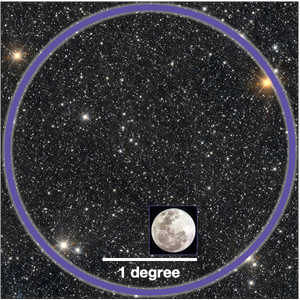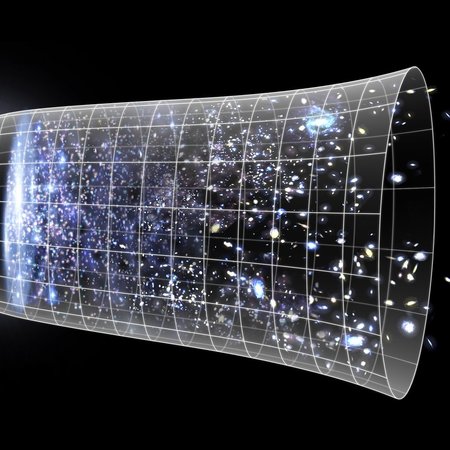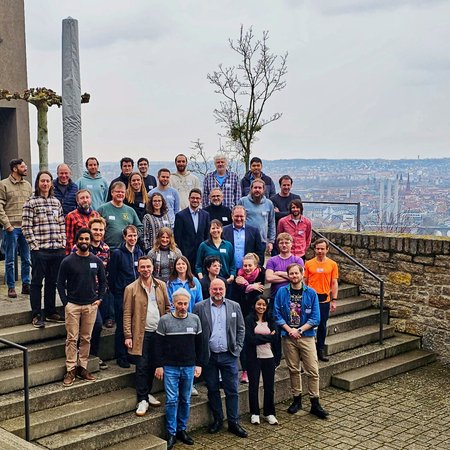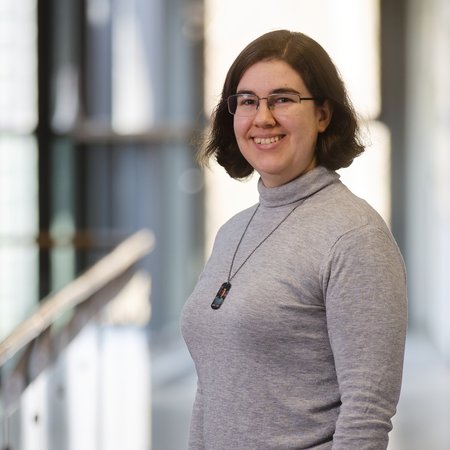First observations: Fifth generation of the Sloan Digital Sky Survey
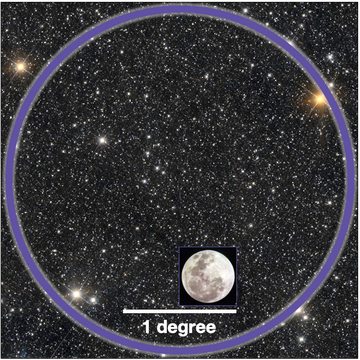
Sky image is a single field of SDSS-V observations. The purple circle indicates the telescope’s field-of-view on the sky (full Moon as a size comparison). SDSS-V simultaneously observes 500 targets at a time within a circle of this size.
Credit: unWISE / NASA/JPL-Caltech / D.Lang (Perimeter Institute) / University of SurreyThe groundbreaking all-sky survey collected its very first observations of the cosmos. It will increase the understanding of formation and evolution of galaxies like our Milky Way. The Leibniz Institute for Astrophysics Potsdam (AIP) is a full member of the SDSS consortium.
The Sloan Digital Sky Survey (SDSS) started in 2000 and has been one of the most-successful and influential surveys in the history of astronomy, creating the most-detailed three-dimensional maps of the universe ever made, with deep multi-color images of one third of the sky, and spectra for more than three million astronomical objects. The just-launched fifth generation (SDSS-V) will continue the tradition set by the survey's previous generations, with a focus on the ever-changing night sky and the physical processes occurring in the objects that comprise our view of it. It will operate out of both Apache Point Observatory in New Mexico, home of the survey’s original 2.5-meter telescope, and Carnegie’s Las Campanas Observatory in Chile, where it uses the 2.5-meter du Pont telescope.
The AIP is a full member of SDSS with usage rights for all its researchers and graduate students. “AIP participation, originally focused on the APOGEE infrared spectrograph, which during SDSS-IV was pioneer in combining South and North observations for the study of the Milky Way, will now expand to study Milky Way galaxy analogs as well thanks to the new SDSS-V data”, says Prof. Dr. Matthias Steinmetz, AIP’s representative in the advisory council of the SDSS collaboration.
SDSS-V will focus on three primary areas of investigation, each exploring different aspects of the cosmos using different spectroscopic tools. Together, these three projects will observe more than six million objects in the sky, and monitor changes in more than a million of those objects over time. The gained data will be publicly available. The survey’s Local Volume Mapper will enhance our understanding of galaxy formation and evolution by probing the interactions between the stars that make up galaxies and the interstellar gas and dust that is dispersed between them. The Milky Way Mapperwill reveal the physics of stars in our Milky Way, the diverse architectures of its star and planetary systems, and the chemical enrichment of our galaxy since the early universe. The Black Hole Mapper will measure masses and growth over cosmic time of the supermassive black holes that reside in the hearts of galaxies as well as the smaller black holes left behind when stars die.
“It is great news that SDSS-V has managed to go ahead despite the difficulties the Covid-19 pandemic brought to all of us. We are eager to work with the SDSS-V new Milky Way data soon, and at the same time trace the best complementary strategies for 4MOST, which will provide in a couple of years the largest Gaia spectroscopic follow-up”, says Dr. Cristina Chiappini, AIP’s lead scientist in SDSS-V.
“Recently, the first eROSITA all-sky X-ray image was released to the public showing an amazing rich content of new X-ray emitting objects. We are in need of SDSS-V to fully exploit the new image of the X-ray sky, and already the very first test plates obtained at Apache point revealed spectra of sources we are looking for”, says Dr. Axel Schwope who represents the AIP in the Collaboration Council and leads the SDSS-V subprogram on Compact Binary stars.
SDSS is managed by the astrophysical research consortium for the Participating Institutions of the SDSS Collaboration. SDSS-V is funded primarily by member institutions along with grants from the Alfred P Sloan Foundation, the U.S. National Science Foundation, and the Heising-Simons Foundation.

This image shows a sampling of data from those first SDSS-V data. The central sky image is a single field of SDSS-V observations. The purple circle indicates the telescope’s field-of-view on the sky, with the full Moon shown as a size comparison. SDSS-V simultaneously observes 500 targets at a time within a circle of this size. The left panel shows the optical-light spectrum of a quasar – a supermassive black hole at the center of a distant galaxy, which is surrounded by a disk of hot, glowing gas. The purple blob is an SDSS image of the light from this disk, which in this dataset spans about 1 arcsecond on the sky, or the width of a human hair as seen from about 21 meters (63 feet) away. The right panel shows the image and spectrum of a white dwarf – the left-behind core of a low-mass star (like the Sun) after the end of its life.
Credit: Hector Ibarra Medel, Jon Trump, Yue Shen, Gail Zasowski, and the SDSS-V Collaboration. Central background image: unWISE / NASA/JPL-Caltech / D. Lang (Perimeter Institute). / University of Surrey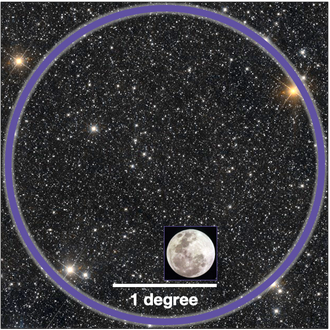
Sky image is a single field of SDSS-V observations. The purple circle indicates the telescope’s field-of-view on the sky (full Moon as a size comparison). SDSS-V simultaneously observes 500 targets at a time within a circle of this size.
Credit: unWISE / NASA/JPL-Caltech / D.Lang (Perimeter Institute) / University of SurreyThe groundbreaking all-sky survey collected its very first observations of the cosmos. It will increase the understanding of formation and evolution of galaxies like our Milky Way. The Leibniz Institute for Astrophysics Potsdam (AIP) is a full member of the SDSS consortium.
The Sloan Digital Sky Survey (SDSS) started in 2000 and has been one of the most-successful and influential surveys in the history of astronomy, creating the most-detailed three-dimensional maps of the universe ever made, with deep multi-color images of one third of the sky, and spectra for more than three million astronomical objects. The just-launched fifth generation (SDSS-V) will continue the tradition set by the survey's previous generations, with a focus on the ever-changing night sky and the physical processes occurring in the objects that comprise our view of it. It will operate out of both Apache Point Observatory in New Mexico, home of the survey’s original 2.5-meter telescope, and Carnegie’s Las Campanas Observatory in Chile, where it uses the 2.5-meter du Pont telescope.
The AIP is a full member of SDSS with usage rights for all its researchers and graduate students. “AIP participation, originally focused on the APOGEE infrared spectrograph, which during SDSS-IV was pioneer in combining South and North observations for the study of the Milky Way, will now expand to study Milky Way galaxy analogs as well thanks to the new SDSS-V data”, says Prof. Dr. Matthias Steinmetz, AIP’s representative in the advisory council of the SDSS collaboration.
SDSS-V will focus on three primary areas of investigation, each exploring different aspects of the cosmos using different spectroscopic tools. Together, these three projects will observe more than six million objects in the sky, and monitor changes in more than a million of those objects over time. The gained data will be publicly available. The survey’s Local Volume Mapper will enhance our understanding of galaxy formation and evolution by probing the interactions between the stars that make up galaxies and the interstellar gas and dust that is dispersed between them. The Milky Way Mapperwill reveal the physics of stars in our Milky Way, the diverse architectures of its star and planetary systems, and the chemical enrichment of our galaxy since the early universe. The Black Hole Mapper will measure masses and growth over cosmic time of the supermassive black holes that reside in the hearts of galaxies as well as the smaller black holes left behind when stars die.
“It is great news that SDSS-V has managed to go ahead despite the difficulties the Covid-19 pandemic brought to all of us. We are eager to work with the SDSS-V new Milky Way data soon, and at the same time trace the best complementary strategies for 4MOST, which will provide in a couple of years the largest Gaia spectroscopic follow-up”, says Dr. Cristina Chiappini, AIP’s lead scientist in SDSS-V.
“Recently, the first eROSITA all-sky X-ray image was released to the public showing an amazing rich content of new X-ray emitting objects. We are in need of SDSS-V to fully exploit the new image of the X-ray sky, and already the very first test plates obtained at Apache point revealed spectra of sources we are looking for”, says Dr. Axel Schwope who represents the AIP in the Collaboration Council and leads the SDSS-V subprogram on Compact Binary stars.
SDSS is managed by the astrophysical research consortium for the Participating Institutions of the SDSS Collaboration. SDSS-V is funded primarily by member institutions along with grants from the Alfred P Sloan Foundation, the U.S. National Science Foundation, and the Heising-Simons Foundation.

This image shows a sampling of data from those first SDSS-V data. The central sky image is a single field of SDSS-V observations. The purple circle indicates the telescope’s field-of-view on the sky, with the full Moon shown as a size comparison. SDSS-V simultaneously observes 500 targets at a time within a circle of this size. The left panel shows the optical-light spectrum of a quasar – a supermassive black hole at the center of a distant galaxy, which is surrounded by a disk of hot, glowing gas. The purple blob is an SDSS image of the light from this disk, which in this dataset spans about 1 arcsecond on the sky, or the width of a human hair as seen from about 21 meters (63 feet) away. The right panel shows the image and spectrum of a white dwarf – the left-behind core of a low-mass star (like the Sun) after the end of its life.
Credit: Hector Ibarra Medel, Jon Trump, Yue Shen, Gail Zasowski, and the SDSS-V Collaboration. Central background image: unWISE / NASA/JPL-Caltech / D. Lang (Perimeter Institute). / University of SurreyImages
Sky image is a single field of SDSS-V observations. The purple circle indicates the telescope’s field-of-view on the sky (full Moon as a size comparison). SDSS-V simultaneously observes 500 targets at a time within a circle of this size.
This image shows a sampling of data from those first SDSS-V data. The central sky image is a single field of SDSS-V observations. The purple circle indicates the telescope’s field-of-view on the sky, with the full Moon shown as a size comparison. SDSS-V simultaneously observes 500 targets at a time within a circle of this size. The left panel shows the optical-light spectrum of a quasar – a supermassive black hole at the center of a distant galaxy, which is surrounded by a disk of hot, glowing gas. The purple blob is an SDSS image of the light from this disk, which in this dataset spans about 1 arcsecond on the sky, or the width of a human hair as seen from about 21 meters (63 feet) away. The right panel shows the image and spectrum of a white dwarf – the left-behind core of a low-mass star (like the Sun) after the end of its life.
Big screen size [1000 x 324, 440 KB]
Original size [1894 x 614, 1.1 MB]
